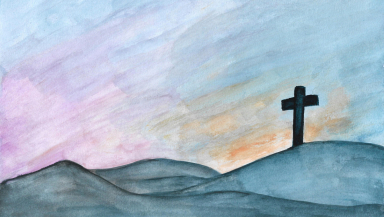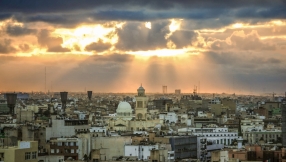
At the heart of the Christian faith is the belief that on the third day after his crucifixion Jesus rose from the dead as the first fruits of the resurrection to eternal life of all God’s people at the end of time. That is why when Christians affirm their faith using the words of the Apostles’ Creed they declare, ‘The third day he rose again from the dead.’
It is clear from the New Testament that Jesus’ rising from the dead meant that the dead body of Jesus that had been placed in a tomb belonging to Joseph of Arimathea (Matthew 27:57-61) had come back to life.
Resurrection meant bodily resurrection which is why, as John reports, the grave cloths which had been placed around the body of Jesus were found lying empty by John and Peter (John 20:5-7) and why the two Marys were able to take hold of Jesus feet' and Thomas was offered the opportunity to touch the nail marks on Jesus’ hands and put his hand in Jesus’ side (Matthew 28:9, John 20:24).
Furthermore, given that it was a bodily resurrection, then it was also a resurrection at a specific place because it is one of the properties of human bodies that they occupy particular points in space. A body is always somewhere and what happens to it consequently always takes place somewhere.
The question of exactly where that somewhere was in the case of Jesus’ resurrection has been highlighted again recently by a report of discoveries by an Italian archaeological team at the site of the Church of the Holy Sepulchre in Jerusalem.
According to a report in the Times of Israel on 22 March this year:
‘Some 2,000 years ago, olive trees and grapevines likely grew on the land where the Church of the Holy Sepulchre in Jerusalem stands today, new archaeological excavations at the site have revealed.'
'The findings mirror a description of the area included in the Gospel of John.
'“Now in the place where he was crucified there was a garden; and in the garden a new sepulchre, wherein was never man yet laid. There laid they Jesus,” reads John 19:19-20.
'The presence of olive trees and grapevines was identified through archaeobotanical and pollen analysis on samples retrieved from the excavations under the floor of the ancient basilica. From the archaeological context and strata, it belongs to the pre-Christian era, however, radiocarbon testing has not yet been carried out.’
The question that the report raises is why the discovery of the remains of an ancient garden in the old city of Jerusalem is linked to the account in John that there was a garden in the place where Jesus was buried (and subsequently rose from the dead). The answer is that the link is made because the church of the Holy Sepulchre where the discovery took place has been identified by Christians as the site of the tomb of Jesus for thousands of years.
According to the fourth century bishop and church historian Eusebius of Caesarea, who was an eyewitness of the events he records, in about 326 AD the Emperor Constantine ordered that the temple of Venus which had been built over the site of Jesus’ tomb by the Emperor Hadrian in 135 AD should be removed and when this took place the tomb of Jesus was discovered under the foundation platform on which the temple was built.
In the words of Eusebius in his Life of Constantine:
‘But as soon as the original surface of the ground, beneath the covering of earth, appeared, immediately, and contrary to all expectation, the venerable and hollowed monument of our Saviour's resurrection was discovered. Then indeed did this most holy cave present a faithful similitude of his return to life, in that, after lying buried in darkness, it again emerged to light, and afforded to all who came to witness the sight, a clear and visible proof of the wonders of which that spot had once been the scene, a testimony to the resurrection of the Saviour clearer than any voice could give.’
The present-day Church of the Holy Sepulchre has been built and re-built over the centuries (an accessible guide to its history is provided by Martin Biddle in his book The Tomb of Christ). However, there is no doubt at all that the rebuilt church covers the site which Constantine’s labourers excavated and that the shrine at the centre of the church, what is known as the Aedicule, covers the site of the ‘holy cave’ referred to in Eusebius’ account.
Constantine and Eusebius believed, and the majority of Christians ever since have believed, that this holy cave was the tomb in which Jesus was buried and the place in which he rose from the dead.
However more recently some Christians (as well as non-Christians) have been sceptical about whether we can be certain that the structure which Constantine’s excavations uncovered, and which is now covered by the Aedicule, really is the site of Jesus’s burial and resurrection.
In the light of this scepticism there are two questions that have to be answered.
The first question is how Constantine’s workmen knew where to dig. The answer to this question is simple. They were guided by unbroken Christian tradition concerning where Jesus died, was buried and rose again. In the words of Carsten Thiede:
‘…. In ancient societies such as that of first- to fourth- century Palestine, the function of tradition was ... not only to safeguard particular modes of behaviour: it was also a means of handing on information from generation to generation. In this sense tradition was a matter of the deadliest seriousness. Diligent memorialization of important sayings and locations was a sacred task, as well as a social duty.
'The sites of tombs were considered particularly significant and are often referred to in the Bible ... In Jesus' day we're told people could point out the burial sites of notables such as Alexander Jannaeus, John Hyrcanus, and Helena Adiabene and her sons. Hegesippus reported that the tomb of James, brother of Jesus, who was killed in AD 62, was still in existence in 175. Before the second Jewish rebellion the sites of the sepulchre of David and Solomon were known and Josephus reports that Herod the Great had restored the edifice.
'It would have been unthinkable for the earliest Christians to forget where their Saviour had been executed, buried and discovered risen from the dead ... It is striking too, that no alternative and more accessible site seems to have been proposed by the ancients. Evidently the tradition was so strong that nobody dared to do so.’
The early Christians were well aware that the sites of Golgotha and the tomb identified by tradition were within the city walls of Jerusalem/Aelia Capitolina even though the biblical record said that Jesus died and was buried outside the city. However, this did not cause them to doubt the tradition because they also knew that the city wall had been extended by Herod Agrippa between 41 and 44 and it was for this reason that the sites were now inside the city.
The second question is why the structure that Constantine’s excavators unearthed was immediately and apparently universally accepted as being the tomb in which Jesus was buried and from which he rose again.
There are two likely answers to this question.
The first is, once again, the authority of tradition. The tomb had been buried beneath the pagan temple for approximately 190 years but before that it would have been a major centre of Christian devotion for over a century. Consequently, there would have been a tradition about what the tomb was like, and this tradition would have been passed down in the church in Jerusalem. There would have been a communal memory of exactly what it was that had been buried under the pagan shrine and what Constantine’s excavators found was that the structure that the Christian community remembered was still there.
The second is that, as Martin Biddle suggests, the tomb may well have been marked by graffiti. We know that the tombs of the saints were marked by graffiti by the early Christians (as in the case of the tomb of Peter in Rome) and this means that the tomb of Jesus was probably also ‘marked in some way, possibly with cut or painted graffiti which were legible in 325/6 and left no doubt in the minds of those (for Eusebius was not the only one, and perhaps not the first) who made the identification.’
In sum, Constantine’s excavators were digging in the right place as identified by the unbroken tradition of the church in Jerusalem, and they found a structure that corresponded exactly to the one that had been buried in the time of Hadrian and which was probably marked by identifying graffiti. Those at the time had no doubt about what they had found and the first version of the Church of the Holy Sepulchre was built to house the remains and to be a centre of Christian worship and pilgrimage (which it has remained to this day).
What all this means for us today is that we can confidently say that Jesus was buried and rose from the dead at a specific place in Jerusalem, that this place is known and is preserved today beneath the Aedicule in the Church of the Holy Sepulchre. To put it another way, Jesus’ tomb is still there and, as it has been since the first Easter day, it is empty.
Christ is risen. He is risen indeed. Alleluia!













